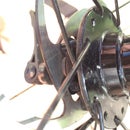Introduction: Make Artisan Soaps (The Easy Way)
You can make soaps, if I can do it so can you.
- It is really is quite easy and simple
- The whole soap making process takes maybe an hour... if that...
- except for the month that you have to wait before you use it.
- Great for gifts, fun craft, if nothing else you can make soap for yourself and stay nice and clean.
- the most important thing is that it saves lots of money.
- We make it because some of us in my family have sensitive skin and this is our solution...
Step 1: Find or Make a Recipe
- Clearly the easiest option is to find a friend to make it for you....
- Probably not the case; but always a great option
- You can however find recipes on the internet; the key part to the recipe is to have the right balance
- the site I use is www.soapcalc.net
- on this site you can enter the type of Lye you are using, the amount of each type of oil you have or want to use and it calculates the amount of Lye you need.
- I used Sodium Hydroxide (NaOH), Red Palm oil/butter, Sunflower Oil, Olive Oil, and Coconut Oil, Cedarwood Oil, very fine sand (from Long Beach on Western side of Vancouver Island, BC) and Water.
My Recipe was as follows(but I split it in two to make different scented soaps)
- Red Palm Oil/Butter 1.5 pounds / 680 grams
- Sunflower Oil 1.5 pounds / 680 grams
- Extra Virgin Olive Oil 1.0 pounds / 454 grams
- Coconut Oil 1.5 pounds / 680 grams
- Lye (Sodium Hydroxide) 12.54 oz. / 356 grams
- Water 2.09 pounds / 948 grams
- Fragrance 2.75 oz. / 78 grams (I only used 8 grams)(Optional)
- 100 grams of very fine beach sand as an exfoliant.(Optional)
Attachments
Step 2: Organize All Tools and Ingredients
**Do NOT use Aluminum** (NaOH will eat away at it)
**Avoid using wooden tools as they can absorb chemicals and are not as easy to clean**
- Lye (I used Sodium Hydroxide)(other types are available but you just alter the recipe with the online calculator)
- Sunflower Oil
- Olive Oil
- Coconut Oil
- Red Palm Oil
- Cedarwood Oil
- 1 Large, 1 Medium Metal bowl
- 1 (4 cup) glass bowl; 1 (6 cup) glass bowl
- 1 Immersion Blender
- 1 rubber spatula
- 1 digital scale
- Several tablespoons
- Thermometer (digital is nicer)
- Medium Sized stock pot
- water
- stove to melt the solid oils
- GLOVES & Safety Glasses ***MUST***
- some sort of mood (I used plant trays from Greenhouse)
- wax paper
- towels/material to wrap your mould in once it has soap in it
- wet cloths for clean up
Step 3: Prepare Oils And/or Fats
- using your scale measure the solid fats into your stock pot to heat them up to 110'F.
- once they get up to about 80+'F turn it off as residual heat will carry the temperature higher
- in a separate bowl measure the liquid fats/oils.
- mix them into the pot once its temperature is up to 110'F
- If you get the temperature to high ... don't stress
- you can always drop the temperature back to 110'F by using a cold water bath with your bowl.
Step 4: Prepare the Lye Mix
***you must use gloves and safety goggles(proper shirt etc. also needed)***
- Measure the water carefully in a metal bowl
- Using a DRY bowl and a DRY spoon measure the quantity of Lye needed (it is moisture reactive otherwise is very stable)
***The Lye MUST be added to the Water in a WELL-Ventilated area***
***You must not do it the other way or the reaction could be very erratic and uncontrolled... SAFETY FIRST***
- Pour the lye into the water and stir... DO NOT STIR WITH YOUR FACE OVER THE BOWL...
You may need to hold the bowl with a cloth or hot pad as it will quickly become very hot and steamy.
**If you get lye on your skin you MUST flush with copious amount of water**
** follow instructions on back of Lye container for more information about safety procedures **
Step 5: Prepare to Mix...
- Once you have the temperature down to 110'F (you can cool it with a cold water bath to speed up the cooling process) you will need to pour the Lye/Water mix into the liquid oils which should also be at 110'F. The temperature does not have to be exact but close.
- Carefully pour the Lye/Water mix into the pot with the oils.
- Using your immersion blender mix the solution.
- Be careful not to lift the blender while running it as it will spray you with your soap mix.
- You will see the colour change as it is mixed. It will turn a more creamy colour and less shiny(more dull)
- Alternate between running the blender and using it to stir a bit but hand (it will probably take about 5 minutes)
- It will begin to look like a pancake(ish) consistency.
- it is called "Trace" when it coats the blender thinly and looks dull
- this is where you can pour any fragrances or colouring into the soap.
- I used only 8 grams of Cedarwood Essential oil. (The recipe says 1.375 oz. I am kinda cheap and I don't really want it strongly scented anyhow
- I also added 100 grams of super fine sand from Long Beach as an exfoliant (make sure it is super fine or use something like oatmeal instead)
Step 6: Pour Into Your Moulds
You can use basically anything for a cold from a wooden box lined with wax paper to plastic cups.
- Me, I used trays that I got from the nursery earlier in the year for my garden plants.
- Just pour it in and cover it with wax paper
- You will need to cover it and keep it warm this is part of the curing of the soap, it cannot cool too quickly
- I wrap my mould with several towels.
- While you are waiting for the next step you can do your dishes.... make sure they are very clean as you were just working with chemicals...
Step 7: Cut Into Bars ... Wait Patiently...
- For the next part you will need a bit of patience.
- a day after mixing the soap you can check if it is hard, if not wait another day...
- you can see in the photo the soap is turning a dark yellow and does not look as jellyfish/translucent
- this is all part of the process of the soap curing.
**USING GLOVES.....***
- Remove the wax paper or cover that you had on the soap.
- Time to remove your mould; if yours is less smooth(not bumpy) it should pop out.(maybe I should have waited a bit more so that it would come free from he mould better)(like I said patience...)
- If some is still on the mould you can just use a bowl scraper and clean your mould and squish it into your other bars. It will harden and work just the same.
- cut the bars into the size you would like. From this recipe you should be able to get 25-30 bars of soap depending on what size you would like.
- I made some a bit smaller for my wife there are 29(1.5"x2.25"x1.25) and 19(1.5"x2.75"x1.5") for myself.
- In a month I will have 48 bars of soap ready to use.
- In total there is 8# 6oz. or 3875 grams of soap curing.
- After cutting the bars stand them up and cover back up in a room temperature location for at least 4 weeks.
- If you do not wait the Lye to finish the Saponification process it will not be as hard as it will get and it can give you a chemical burn. will not have left the bars of soap and will not only clean you will give you a chemical burn....
- Patience is a virtue... so they say but the reward is awesome homemade soap or a great addition to someones Christmas/Birthday present.

Runner Up in the
Coconut Challenge












